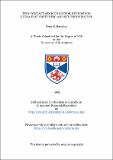Files in this item
Two-contact semiconductor devices for ultra-fast switching and synchronisation
Item metadata
| dc.contributor.advisor | Sibbett, Wilson | |
| dc.contributor.advisor | Adams, Mike J. | |
| dc.contributor.author | Barnsley, Peter E. | |
| dc.coverage.spatial | 242 p. | en_US |
| dc.date.accessioned | 2018-06-18T09:20:57Z | |
| dc.date.available | 2018-06-18T09:20:57Z | |
| dc.date.issued | 1993-07 | |
| dc.identifier.uri | https://hdl.handle.net/10023/14159 | |
| dc.description.abstract | The information contained within this document is a study of the properties of two-contact semiconductor laser devices. The emphasis of this study was on understanding the behaviour and properties of semiconductor laser devices where regions of saturable absorption are introduced into the Fabry-Perot cavity, and to demonstrate that the inherent nonlinearity of such a device can be harnessed to provide all-optical switching and routing functions that could be incorporated within future multi-gigabit optical telecommunications networks. Important advances in the field are presented in the assessment and performance of such two-contact functional components when operated both below threshold, as nonlinear optical amplifiers, and above threshold, as self-pulsating lasers. Detailed measurements on the nonlinear optical amplifiers are presented defining the dependence of both the steady state and dynamic characteristics on optical input power and wavelength. These results are compared with theoretical predictions from a model incorporating material gain calculations based on strict momentum conservation. It is shown that such devices can be used to convert the wavelength of Gb/s data between the 1.3mum and 1.55mum telecommunications window of silica fibre, and that fast all-optical switching of gigabit/s data packets with sub-ns rise and fall times is achievable. Detailed system data Bit-Error-Ratio (BER) measurements are used to highlight the systems potential of such functions. Also presented are significant advances in the field of self-pulsating laser devices and their use in multi-gigabit all-optical clock recovery circuits. The pulsation behaviour is investigated in detail and a detailed study of the locking behaviour of these devices for Return-to-Zero-'soliton' data format made. Some of the properties investigated are: tuning and locking range, clock purity, data pattern dependence, clock lock-up time, pulse spectral variation (chirp). In addition BER measurements using the clock recovery circuit in a 20 Gb/s OTDM system has demonstrated their potential application. Operation with Non-Return-to-Zero format data is also demonstrated in combination with the nonlinear amplifier devices. In summary the results contained within this thesis show that two-contact devices have characteristics and functionality suitable for use in many application areas consistent with the development of future synchronous gigabit all-optical telecommunication networks. | en_US |
| dc.language.iso | en | en_US |
| dc.publisher | University of St Andrews | |
| dc.subject.lcc | TK7871.85B2 | |
| dc.subject.lcsh | Semiconductors--Lasers | en |
| dc.title | Two-contact semiconductor devices for ultra-fast switching and synchronisation | en_US |
| dc.type | Thesis | en_US |
| dc.type.qualificationlevel | Doctoral | en_US |
| dc.type.qualificationname | PhD Doctor of Philosophy | en_US |
| dc.publisher.institution | The University of St Andrews | en_US |
This item appears in the following Collection(s)
Items in the St Andrews Research Repository are protected by copyright, with all rights reserved, unless otherwise indicated.

